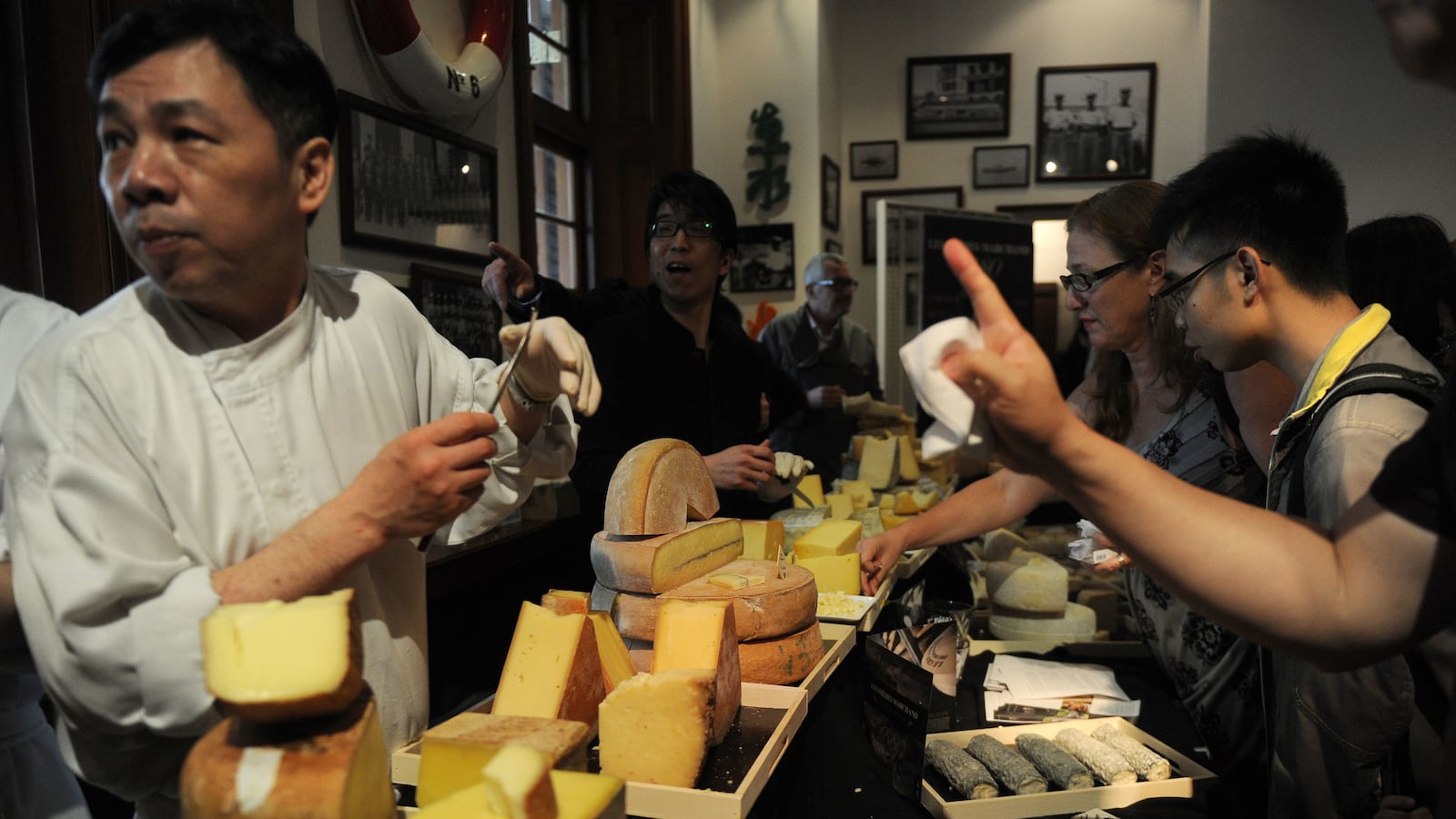It’s 7:50 p.m. on a Thursday, last call for happy hour at Enoterra, one of Shanghai’s trendiest wine-and-cheese joints for the young and upwardly mobile. At the bar, a trio of sharply dressed Chinese twentysomethings beckon for one more round of rosé. Before them sits a single schmear of brie on a wooden board—all that remains of a platter that, moments ago, held an array of cheeses hard and soft.
The loudest of the three young women says something, and as her two friends giggle approvingly, she victoriously scoops up the brie with her fingers, raises her eyebrows provocatively at her companions—“Do I dare?”—then pops the whole thing into her mouth, closing her eyes as if in reverie.
A few short years ago, says Pierre Monie, such a scene would have been nearly unthinkable. As Enoterra’s managing director, he is among the vanguard of restaurateurs bringing cheese to China’s exploding food scene.
But while Western products from caviar to KFC have caught on quickly, it’s only now that cheese is finally breaking into the world’s fastest-growing consumer market. Enoterra has been serving cheese platters since it opened eight years ago. The difference today, Monie says, is that “we see now that the platters are not coming back to the kitchen untouched.”
Cheese hasn’t historically been a part of Chinese cuisine, and as China has opened up cheese has taken longer to catch on than other Western foods because the taste of cheese is so exotic to the Chinese palate.
“Five years ago the Chinese were eating virtually no cheese,” says Alan Levitt, vice president of communications for the U.S. Dairy Export Council. Now, like all things China, the numbers are shooting through the roof. America sent less than 2,000 metric tons of cheese to China in 2009. “Last year we were at 11,000,” Levitt says.
It’s all thanks to a new generation of globe-trotting, trend-obsessed Chinese, many of them young and experimental in ways their parents couldn’t dream of. They are young people who studied abroad and brought their newfound love of sharp cheddar back to Beijing, as well as the millions of former farmers moving to cities, where they’re exposed to globally sourced products for the first time.
China produces virtually none of its own cheese at the moment—it is just now starting to import the knowledge and machinery to do so, but a full-fledged domestic dairy industry remains years away.
“We’ve noticed that the order of the cheese platter almost responds to a call for curiosity. After a couple of trips abroad, the Chinese actually enjoy cheese,” says Monie, adding that 18 percent of Enoterra’s food sales in the last six months were cheese platters.
The trend is fueling not only the rise of swanky high-end cheese bars, but also a boom in franchise restaurants like Papa John’s and Pizza Hut—places where families gather for a big night out. “You don’t just zip through the drive-thru” of Pizza Hut in China, says Levitt. “Fast-food places are an occasion for eating out.”
Even supermarkets are starting to sell cheese to the country’s badminton moms. “The retail side is growing more slowly,” says Levitt, “but we do see moms buying processed cheese as a snack or breakfast item, and we see that as prepping the next generation for cheese consumption.”
It doesn’t hurt that, in a country where dairy options are limited, the Chinese government’s official stance these days is that every child in China be given at least one serving of dairy per day.
“The Chinese currently have a one-child policy, and so parents will provide that child the best possible food—they dote on their children,” says Jen Pino-Gallagher, bureau director for the Division of Agricultural Market Development at the Wisconsin Department of Agriculture, Trade and Consumer Protection. “So if they see cheese as a great protein, they will give it to their kids.”
Wisconsin is all too happy to help Chinese moms see cheese this way. Last June, the state worked through the U.S. Department of Agriculture’s Shanghai office to bring big-wig Chinese cheese importers to the Badger State. “They came to Wisconsin, they sampled cheeses, they met with cheese industry leaders,” says Pino-Gallagher. “They had a blogger and were constantly taking pictures and sending back news articles.”
Efforts like these are part of a full-court press to get Chinese taste buds used to cheese—not easily done in a country where dishes like tea-smoked duck don’t exactly scream for a dollop of Velveeta. “It’s not a part of the Chinese palate,” says Lisa Stout, economic development consultant for the Wisconsin Department of Agriculture’s Division of Agricultural Market Development. “It’s a new frontier for them.”
As such, Stout says the strategy is to get Chinese consumers started on what she calls “entry-level cheeses”: things like cream cheese, which can be used in baking, followed by mild cheeses like mozzarella. Working them up to more pungent varieties takes time. Even among the sophisticated clientele at Enoterra, “Blue cheese and other strong cheeses… are the ones that come back to the kitchen in full,” says Monie.
But while developing a taste for cheese in China might be good for Big Ag, in the short term at least, it could stick Americans with a bigger bill for their Dominos delivery. In March, U.S. cheddar prices hit record highs when a surge in exports to China reduced domestic supplies. “It’s getting very easy for easy for the Chinese consumer to get this cheese,” says Pino-Gallagher. “They’re demanding it.”






